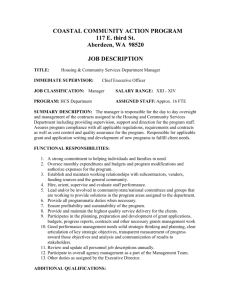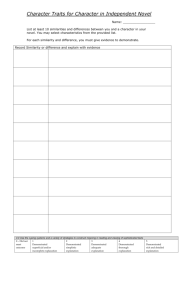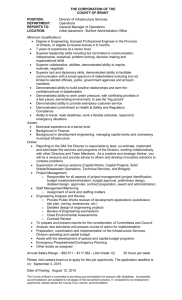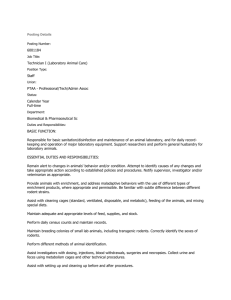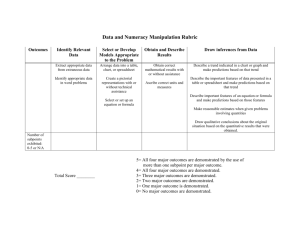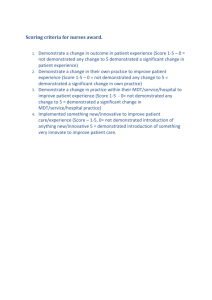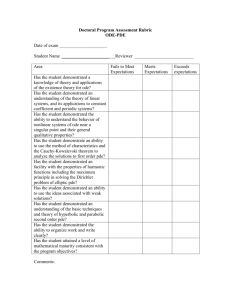Writing position descriptions - University of South Australia
advertisement
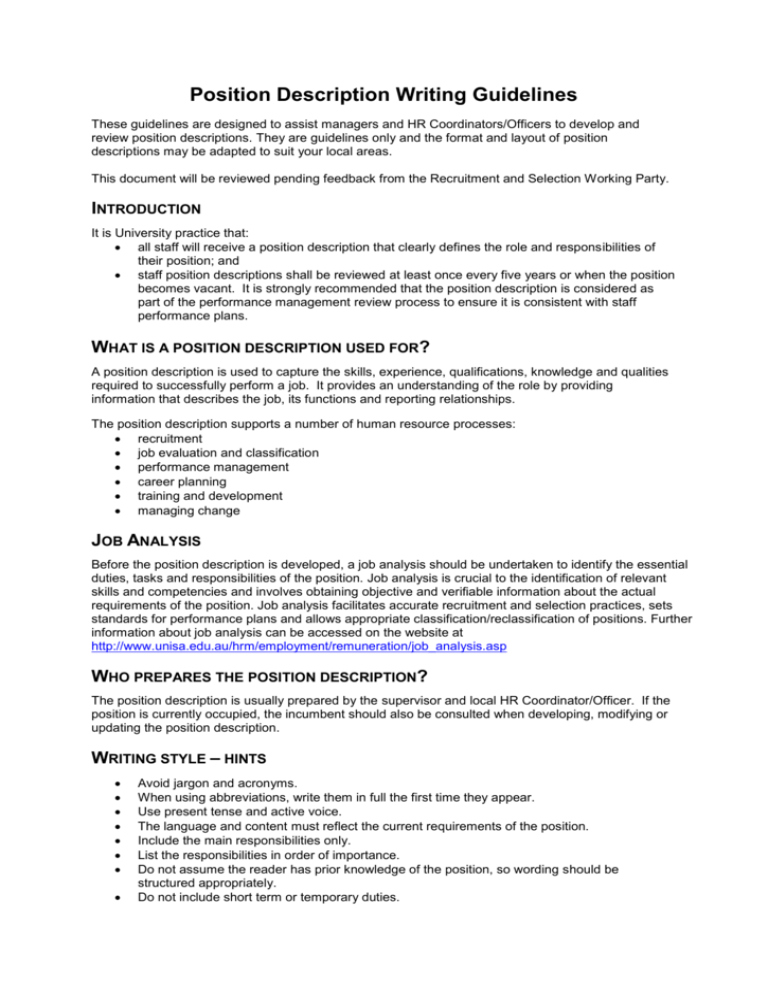
Position Description Writing Guidelines These guidelines are designed to assist managers and HR Coordinators/Officers to develop and review position descriptions. They are guidelines only and the format and layout of position descriptions may be adapted to suit your local areas. This document will be reviewed pending feedback from the Recruitment and Selection Working Party. INTRODUCTION It is University practice that: all staff will receive a position description that clearly defines the role and responsibilities of their position; and staff position descriptions shall be reviewed at least once every five years or when the position becomes vacant. It is strongly recommended that the position description is considered as part of the performance management review process to ensure it is consistent with staff performance plans. WHAT IS A POSITION DESCRIPTION USED FOR? A position description is used to capture the skills, experience, qualifications, knowledge and qualities required to successfully perform a job. It provides an understanding of the role by providing information that describes the job, its functions and reporting relationships. The position description supports a number of human resource processes: recruitment job evaluation and classification performance management career planning training and development managing change JOB ANALYSIS Before the position description is developed, a job analysis should be undertaken to identify the essential duties, tasks and responsibilities of the position. Job analysis is crucial to the identification of relevant skills and competencies and involves obtaining objective and verifiable information about the actual requirements of the position. Job analysis facilitates accurate recruitment and selection practices, sets standards for performance plans and allows appropriate classification/reclassification of positions. Further information about job analysis can be accessed on the website at http://www.unisa.edu.au/hrm/employment/remuneration/job_analysis.asp WHO PREPARES THE POSITION DESCRIPTION? The position description is usually prepared by the supervisor and local HR Coordinator/Officer. If the position is currently occupied, the incumbent should also be consulted when developing, modifying or updating the position description. WRITING STYLE – HINTS Avoid jargon and acronyms. When using abbreviations, write them in full the first time they appear. Use present tense and active voice. The language and content must reflect the current requirements of the position. Include the main responsibilities only. List the responsibilities in order of importance. Do not assume the reader has prior knowledge of the position, so wording should be structured appropriately. Do not include short term or temporary duties. Avoid gender specific language. Do not include Key Result Areas (KRAs). STRUCTURE OF THE POSITION DESCRIPTION The following section provides a guide to writing position descriptions using the preferred University format. A number of position description templates and examples are available on the website to assist managers and HR Coordinators/Officers develop a position description. The templates consist of an information package cover sheet and the actual position description. Position Title Guidelines have been developed to provide managers with clear information and options for the application of position titles. Position title guidelines Work area This should tell the applicant in which School, Unit or Institute the position is based. The Division or Portfolio may also be added to provide further details. Examples: International Graduate School of Business Division of Business or Finance Unit Finance and Resources Primary campus/location The primary campus/location is the main campus or off-campus location where the position is based, usually where the incumbent’s office is situated. It is useful to note that University employment contracts state that an employee may be moved to a new campus or location at any time. Classification Classification of the position may be determined through a number of mechanisms. Academic positions: Classification of academic positions is determined by the University’s academic position classification standards as contained in the relevant industrial instrument. Examples: Research Associate, Academic Level A Senior Lecturer, Academic Level C Professional and general staff positions: The HR Unit evaluates and classifies positions based on information provided in the position description, the organisational structure of the work area and by comparing other similar positions within the University. Please refer to Classifying Positions Guidelines Example: Higher Education Officer 4 (HEO4) Employment type Employment type is determined during workforce and position planning. The position type will be continuing, fixed-term contract or casual (refer to the applicable industrial instrument). The position may also be full-time or fractional-time. Example: 2 year fixed-term contract Context statement The position description should include a brief paragraph about the Division and how the School fits within the Division structure. For Units, Institutes and Research Centres, simply introduce the area where the position is based. This paragraph is an opportunity for the manager to promote their work area to potential applicants. In particular this assists internal applicants from other areas in the University wishing to apply for the position. Examples: School The Division of Business consists of four schools with approximately 11,000 students, half of which are international students studying in Adelaide and in a number of offshore locations. Undergraduate and postgraduate course-work programs, and research degrees (doctoral and masters) are offered. The Division is internationally recognised for the quality of its programs – it was the second business school in Australia to be accredited by the European Quality Improvement System, and the first to have its offshore programs accredited. The School of Marketing is one of Australia's largest Schools of Marketing with a number of specialist academic staff. It has active research programs and offers the widest range of marketing courses in South Australia. The School of Marketing aims to integrate the different aspects of University culture - research, industry links and teaching into an Institute named after the key intellectual minds of Ehrenberg and Bass. Unit The Human Resources Unit provides strategic HR leadership to encourage best practice in the management of the staff of the University of South Australia. It supports a distributed human resources environment through leadership, policy development, senior operational services, consultancy and advice. The Human Resources Unit is located at 101 Currie Street, City West Campus. Institute The Ian Wark Research Institute (The Wark™), at the University of South Australia, is the Australian Research Council Special Research Centre for Particle and Material Interfaces. With 130 staff and postgraduate students, it is recognised internationally as one of Australia’s premier research facilities and a world leader in particle and material interfaces. It is a significant contributor to the ongoing wealth and success of the minerals and other industries in Australia and globally. The Wark conducts its research across four sectors - Materials and Environmental Surface Science, Bio and Polymer Interfaces, Colloids and Nanostructures, and Mineral Processing. Purpose of position This section should contain a brief statement that explains the overall purpose of the position. It should not be a detailed account of the duties and responsibilities as that comes later. The position purpose provides a snapshot of what the position is expected to accomplish and why the position exists. Examples: (a) The position provides high level administrative and research related support to the Indigenous College of Education and Research to support the ongoing development and maintenance of its research, consultancy and publishing activities. (b) The Research Associate will contribute to the research effort of the Ian Wark Research Institute and will develop his/her expertise through defined research projects relevant to particle and material interfaces. Position environment This section should set the context for the position and how it interacts with key stakeholders within and external to the University. An organisational chart should be attached to provide the applicant with an overview of the area and where the position fits. Include the title of the position the role reports to and the positions that the role is responsible for (do not include names). The location of the position should also be included, i.e. “Although the location of the position is at Magill Campus, you may be required to undertake duties at any of the University’s metropolitan campuses.” Examples: (a) The Administrative Officer reports to the Head of School through the School Executive Officer. The position’s key internal customers include school academic, professional and general staff, current and prospective students and administrative staff from other schools. External customers include industry, government, professional and community organisations. There are two positions reporting to this role, the Clerical Officer and the Receptionist. (b) The Program Support Officer reports to the School Coordinator for the purpose of performance management and structure and in addition will have functional reporting to the Program Directors for work allocation and management. Although this role has no direct reports it is expected that the role will delegate and coordinate some administrative work within the School’s administrative group. Core responsibilities This section of the position description should define the main responsibilities of the position, and the expected outcomes or results. The information contained here will ideally provide the base information for the creation of the incumbent’s performance management plan. This can be achieved by grouping similar activities together to form generic groups. Examples: Academic Staff Leadership Research Knowledge Application Educational Development and Practice Professional and General Staff Project Management Financial Management Research Support Program Administration Academic Administration The outcome statements should clearly demonstrate what is to be achieved (the end result of actions) and how that action is taken. This should not contain a list of duties or detailed tasks, but broad statements. When completing this section, use the following questions as a guide: What are the key objectives/outcomes of the position? What are the main functions of this position? What is the position responsible for, and why? How does the position contribute? Who are the customers – both internal and external? Do not over-use words such as “coordinates” or “assists” unless the depth of involvement in the task is included. This will avoid creating the impression that the role has a secondary involvement and therefore less accountable for the outcome. Examples: Develop and oversee the implementation of marketing and business development strategies (what) by building links and income producing business partnerships with industry (how). Ensure the financial viability of the School (what) through developing and supporting appropriate strategies for commercial projects, international activities, research, consultancy and enrolments (how). Manage the effective administration of the programs (what) and report, document and develop recommendations regarding matters of resource and administration (how). Organise and manage various training sessions, seminars and workshops (what) by planning, costing, taking registrations, assisting with the development of training materials and booking resources and equipment (how). Actively support the creation and development of a research program (what) by identifying appropriate research opportunities and partners and taking an active role in setting up effective working relationships with groups and individuals (how). If required, more information can be included in the position description to articulate the key challenges that currently effect the position. Examples: A key challenge for this position is to implement the University’s Occupational Health and Safety action plan in the School. A specific challenge over the next 12 months is to research and develop a new records management system. Special requirements Examples of when to use this field: The position is based at one campus but is expected to spend time working at another campus. Includes a rostered work system within the standard opening hours. Some out of hours work and international and domestic travel is expected. Flexible work arrangements will be negotiated for this position. Standard University Staff Requirements The University has specific requirements that relate to Occupational Health and Safety matters that should be detailed on the position description. The requirements are specific to the level of position that is being recruited. Selection criteria The selection criteria form the basis of the selection strategy. It will determine the type of person that would be ideal for the position. The selection criteria will detail the necessary skills, experience and aptitudes that the potential applicants should possess to carry out the accountabilities of the role. They should be ranked in order of importance The selection criteria should be written by analysing the responsibilities and outcomes of the position. Examples: (a) A core responsibility for a Senior Lecturer may be “preparation and delivery of face-toface and online courses in graduate and postgraduate programs”. An analysis of this statement for the selection criteria may be “experience in online teaching and the use of a variety of technological media” or “demonstrated experience in flexible teaching delivery methods”. (b) A core responsibility for a Team Leader may be “providing leadership, management and support to a service delivery work team”. After review of current University management practices such as performance management, an analysis of this statement for the selection criteria may be “proven ability to manage a team in a busy environment with conflicting demands” or “experience in managing and developing staff through a performance management framework”. Selection criteria should support the job analysis and position description and should not introduce any additional information or duties. The selection criteria should only contain the skills, attributes and experience that the candidate must have to carry out the duties of the position. Creating Selection Criteria The selection criteria should accurately identify the minimum competency level required in the position. Ideally there should only be 4-6 criteria, however this will vary from position to position. The essential criteria should reflect what is essential to fulfil the requirements of the position, and will give potential applicants an understanding of whether they are suitable for the position or not. Do not overstate the qualifications and training required of the role. A tertiary qualification on its own should only be used when it is essential to the role. (eg Academic positions, Finance where a degree is required) If a tertiary qualification is preferred it should be shown as “tertiary qualifications in a relevant field or demonstrated equivalent experience, knowledge and skills”. Do not specify “previous experience” if it can easily be learnt on the job as this may limit the pool of applicants. When special skills are required to do the job it may be more appropriate to state “demonstrated ability to interpret legislation” than “knowledge of the Superannuation Guarantee Legislation”. Explicit skills or experience should only be included when absolutely essential, (for example, a particular software package), as this could deter potential quality applicants who might need only minimal training to meet the specific requirement. “Must have a valid drivers licence” should not be added to the criteria unless the position necessitates travel to areas where public transport or taxis or other methods of travel are unavailable. If this is the case the core responsibility should be clearly described in the position description and the skill included in the criteria. The selection criteria should contain only one or two related skills or attributes, for example: demonstrated commitment to customer service in a demanding environment”. There are two concepts in this criteria statement but they are inter-related (customer service skills and the ability to work and apply these skills in a busy environment). Good criteria statements should contain only one sentence. If there is more than one statement or concept, this should become a separate criterion. Selection criteria ask an applicant to show or discuss their experiences and knowledge. Generally selection criteria will be statements that begin with the following: o Ability to … o Demonstrated experience … o Proven ability … o Experience in … o Knowledge of … o Qualifications in … Desirable Criteria Desirable criteria are the skills, experience, qualifications, aptitudes, or attributes that the manager would ideally like the potential candidate to have. If the manager believes that there is a small pool of talent for a particular position he/she may choose to only have one or two essential criteria and have a number of desirable criteria. This will encourage a broader range of applicants. This is particularly useful if the manager is offering the position as a development opportunity. A list of selection criteria examples appear in Appendix 3 and should assist managers to create appropriate criteria statements Assistance available Assistance is available from the following sources: Human Resources Unit – HR Services Team Local HR Coordinators and Advisers Appendix 1 Example Selection Criteria Statements The following statements are provided as a guide and may be altered to suit your specific situation. Leadership/Management Skills Proven ability to manage, supervise and provide leadership to a small team. Demonstrated capacity to provide leadership in the development and implementation of strategies to successfully deal with contemporary issues. Ability to lead, supervise and develop administrative staff, including experience with performance management processes. Demonstrated project management experience, including record keeping, preparation of proposals; knowledge of contractual agreements; and proven financial skills. Proven ability to provide leadership in X. Interpersonal and Communication Skills Demonstrated excellent written, verbal and interpersonal skills. A high level of interpersonal and communication skills. Excellent interpersonal skills including demonstrated experience and skills in liaison, negotiation and conflict resolution with staff at all levels. Outcome and Result Focused Excellent organisational and planning skills in managing a personal workload in a busy environment with conflicting demands Demonstrated high level of organisational skills including the capacity to set priorities and work to deadlines. Technical Skills/Knowledge Experience in the use of Microsoft desktop products such as Word, Excel and Outlook. Demonstrated ability to design, cost, implement and manage projects. High level written and oral communication skills including demonstrated skill in production of research reports, conference papers and educational publications. Highly developed computer literacy skills including the capacity to effectively use email, word processing, web searching and project management software. Demonstrated experience in developing and maintaining quality systems. Teaching and Learning Demonstrated commitment and experience in teaching in X. Experience in information management systems, including internet and on-line environments. Evidence of the ability to undertake high quality teaching in a tertiary education environment. Research Demonstrated skill in developing policy recommendations and intervention plans based on research evidence. Demonstrated proficiency in conducting applied research. A demonstrated ability to supervise research students. Demonstrated impact of recent research. Recent success in applying for research grants. A demonstrated ability to carry out industry based research and/or relevant industrial experience. Demonstrated high level of research and analytical skills. Decision Making High level problem solving skills and research/ analytical ability including the ability to obtain and interpret information and make specific recommendations. Proven ability to exercise sound judgment in complex decision making. Customer Service Communicating with and assisting a diversity of clients with a demonstrated commitment to customer service. Demonstrated achievement in and enthusiasm for the provision of quality customer service. Demonstrated commitment to customer service and continuous improvement. Flexibility, Initiative and Managing Change Demonstrated self-motivation and ability to work independently. Demonstrated ability to provide leadership to a team during periods of organisational change. Experience in developing and implementing organisational change programs. Teamwork Skills Effective organisational and administrative ability and the demonstrated ability to work in a team. Ability to work effectively as part of a team in a fast changing environment, to work productively with limited supervision and to work to deadlines. Demonstrated commitment to teamwork and the maintenance of a supportive work environment. Continuous Learning and Professional Development Enrolment in post-graduate degree in an area of X or related to Y. A doctorate (or equivalent accreditation and standing) in a relevant discipline. Tertiary qualifications in a relevant field or demonstrated equivalent skills and experience. Demonstrated commitment to continual professional and personal development.
